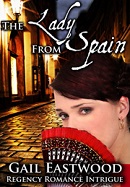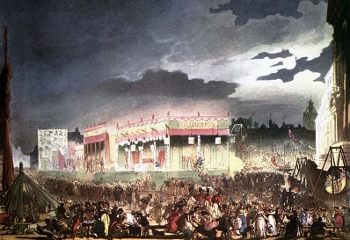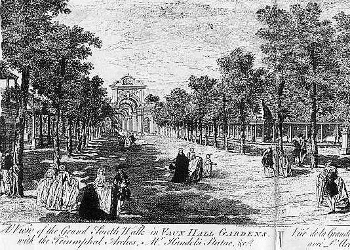I’m delighted to introduce today’s guest, Gail Eastwood.
Gail worked as a journalist, theatre critic and PR consultant before she penned her first romance novel, A Perilous Journey. Since then, she has written six more Signet Regencies which have been nominated or won awards including the NJRW Golden Leaf, the Holt Medallion, and Romantic Times Book Club’s Reviewers’ Choice Awards. She also teaches writing and takes an avid interest in theatre, historical dance and costuming. Her books are known for their emotional depth, mystery and adventure and innovative characters and plot elements, such as a hero who is a French prisoner of war (The Captain’s Dilemma).
But the real reason I’m so thrilled to welcome Gail is that like me, she is making a comeback after having to take a break from writing to deal with serious family health issues. Starting sometime last fall, we have been emailing each other regularly to cheer each other on and help each other balance our creative lives with the continued challenges of caring for our loved ones. Gail has been a wonderful support to me; she is not only talented, but one of the kindest writers I know.
Today we’re going to talk about Gail’s upcoming ebook reissues, A Perilous Journey (available now) and An Unlikely Hero, coming in July. Enter a comment or question for the chance to win a Kindle or Nook copy of A Perilous Journey (winner to be chosen by the Riskies).
Praise for A Perilous Journey and An Unlikely Hero
“A scintillating debut…(Gail Eastwood) charms us with her sparkling storytelling.” – Romantic Times Book Reviews (A Perilous Journey)
“The brilliantly versatile Gail Eastwood changes pace once again to bring us a frothy Regency delight spiced with touching emotion…. beguiling characters and zesty interplay.” – Romantic Times Book reviews (An Unlikely Hero)
Tell us about these two stories.
These two books tell the related-but-separate stories of twins Gillian Kentwell and her brother Gilbey, Viscount Cranford. When we first meet them in A Perilous Journey, headstrong Gillian has run away from home after finding no other way to avoid the marriage to an elderly neighbor her guardian has arranged. She has romanticized ideas about Scotlandand is heading there, hoping to find refuge with an aunt she has never met. Gilbey has come along to try to protect her, knowing that she will never give up the 400-mile path she has chosen. Young and inexperienced, they are already in trouble their first night out. That’s when they meet up with Julian Rafferty de Raymond, the Earl of Brinton, still one of my favorite heroes. Brinton rescues them twice in less than 12 hours, and by then is hopelessly ensnared by his own curiosity, not to mention his attraction to Gillian.
Their progress north through western England (including a stopover in Bath) includes misadventures and detours as they try to evade their pursuers, always driven by the question of whether or not they will be caught before they can reach their destination. Anyone who travels, even today, knows that it can test the best of relationships, but it can also forge strong bonds. The journey these three characters undertake certainly does both! A surprise awaits them in Scotland, however, and they must face more challenges before Gillian and Brinton can earn a happy ending.
Gilbey’s happy ending is that he is going to be sent off to university. An Unlikely Hero takes place after he has been there three years and is the story of what happens when one of his Cambridge pals, the son of a duke, convinces him to attend a house party at the duke’s estate. Gilbey is a reluctant guest enlisted to help keep watch over his friend’s sisters, identical twins known as the Lioness and the Lamb. They are notorious for refusing marriage offers and testing their suitors, but this time their father has drawn a line, declaring that they must finally choose husbands from among the assembled guests.
The twins’ behavior is not all capriciousness and mischief—they have a dark secret, and one of the guests is trying to use it to blackmail them into a marriage. Gilbey, fighting his attraction to the beautiful twins, finds trying to meet the expectations of everyone around him challenge enough for his wits. The Duke has made it clear that Gilbey is not eligible and must keep his distance. The suitors have made it clear they don’t appreciate any perceived competition from Gilbey. But Fate keeps landing him repeatedly in the twins’ path and the center of attention. How can a hero worth his salt not step up to help them? What help is there for his heart, irretrievably lost to a twin he can never have?
What inspired you to write each?
A Perilous Journey, which was my first novel, was stuck in my head for many years before I finally realized no one else would ever write this story—only I could release it! Does that sound completely weird? I always wanted to be an author, and I worked as a journalist for many years, but I just somehow thought someone else would think of this story and write it. LOL! Writing an entire novel is a daunting prospect when you first begin—even for an experienced writer. Maybe I was avoiding the reality of that, or the time just wasn’t right, or the story needed all that time to percolate.
An Unlikely Hero, on the other hand, was a story I never planned to write. Gilbey is such an antithesis of your typical romance hero—he wears glasses, he’s so fair he blushes, he’s a little accident-prone and he’s a total geek! I was surprised when readers wrote to me and approached me at booksignings asking when I would do his story! As soon as I said, “He isn’t really a romance hero,” he started kicking me and protesting the way I had pegged him. He is unfailingly loyal and sweet. I realized that, like all good Beta heroes, he had what it takes underneath, and that stripping away his outer layers to reveal the hero inside would be so much fun to do. But I didn’t have a lady for him, and that makes it pretty hard to have a romance!
Venetia and Vivian St. Aldwyn walked up to me in a dream, and I knew immediately one of them was meant for him. But they were smart, beautiful, rich daughters of a duke—what was their problem? You know, no conflict, no story! I muddled over that for a few days before I saw an article in my local paper that totally sparked the idea for the secret that drives them. I loved the idea that underneath the romance in this book there might also be a social message. I love that a little history always gets taught with each book, too!
Were there any particular challenges you encountered in your research? Any new or surprising historical information that you discovered?
I love, love, love to research. Stopping to actually write the story can be the challenge! A Perilous Journey required a ton of research because of all the locations in the story, not to mention understanding methods of travel in 1816, and so much more. I did some of my research “on location” in England, and at least one incident in the book, at Morecambe Bay, was inspired by the delightful and purely serendipitous discovery of the Hest Bank Hotel and its long history as a rescue station for people caught by the bay’s tidal bore. Who could resist?

Settings are important to me as a “world-building” element of story. The location of the duke’s estate in An Unlikely Hero was carefully chosen and researched. The surname I gave the duke’s family also derived from the local area where the story is set, and that led to a surprise. Five years after the book was published I got an email from the Earl of St. Aldwyn, a modern-day English peer, asking about the book characters’ names. Yikes! I always research my made-up title names to be sure they don’t actually belong to anyone, and I was in the clear, since the title names I used were Roxley and Edmonton, not St Aldwyn. But I hadn’t checked on St. Aldwyn, since I only used it for a family name! As I reassured the earl, that name came “straight off the map” and most certainly was not intended to reflect any connection to his family. He asked for a copy of the book, which of course I was happy to send!
We pride ourselves in writing Risky Regencies. Tell us what is risky about your books?
Wow, there are so many answers to this! One risk now, of course, is whether or not the freshness in these stories still holds up after all this time, or if the stories can still charm readers anyway. I suppose the greatest risk is the chance of writing something that readers won’t want to read or won’t “get” when you write against type, which I like to do. I recently described what I write as “kind of off-beat sweet Regencies with a twist of suspense.” When my books were first being published (1990’s), I was lauded for pushing the genre’s boundaries. I was nominated for RT’s Career Achievement Award twice, and people asked me if I was trying to invent a new sub-genre, the “Regency Intrigue”. We were just beginning to break out from the “drawing room comedy” style of traditional Regency that many readers still love and prefer. The genre has expanded so much since those days, I doubt anyone would think my stories are ground-breaking now, but at the time I wanted deeper emotion and more plot. Mary Jo Putney and Mary Balogh and a few others were heading that way, too. I wanted to be able to do some darker stories. I wasn’t sure if I was writing Traditional Regencies or Historicals—what I wrote was something in between! That was a risk, and I will always be grateful to Signet for going along with it.
I am drawn to write about things that I haven’t seen done. Venturing off the path can be a great way to risk falling on your face, though, LOL. For instance, when I tackled The Captain’s Dilemma (1995), I wasn’t sure a romance between an English miss and a French prisoner of war could even be successfully done, given the depth of the conflict. I hunted and hunted for other stories that tried this idea and found almost none (and those I found did not really succeed as romances). That was scary! Yet my research showed that there really may have been some true-life cases, and I really wanted to do that story. For The Lady from Spain I wanted to do a story where the heroine was seeking revenge, instead of the man. (That’s not so unusual to find now!) In The Rake’s Mistake, I wanted to do something with pleasure sailing on the Thames, totally charmed by an engraving I saw. I like to take my characters out into an expanded Regency world not limited to the ballrooms and Almack’s. I am so grateful that readers have been willing to go along!
I haven’t even touched on book-specific “risky writing” and if this wasn’t already too long, we could also talk about the emotional risks characters face. I’m sure we could talk about this stuff for hours!!!
What is it that most excites you about the Regency setting?
I think Beatrix Potter and A.A. Milne started my love affair with England long before I found Jane Austen, but it’s also in my blood –a raft of English ancestors must surely influence me, because I always feel like I’ve come home whenever I have the privilege of visiting over there. Of course there’s another theory –a psychic once told me I lived during the Regency. Do you believe in past lives? It’s a shame I can’t recall any of it –think of all the research time that would save! Despite my tendency to expand beyond them, I do love the clothing, the balls, the glittering lifestyle of the upper reaches of society in this period. The aristocracy were the celebrities of their day! I love the elegance, and the elegant language. But I also think part of the appeal is that it was a transitional time, bridging the 18th century “Age of Enlightenment” and the more modern Victorian era when the world became industrialized and much more recognizable to us. Regency people were living in a time when things were changing at a much faster pace than ever before in history, and I think that resonates with us today—we all face the challenges of adjusting. Challenges make good stories, and when we write about this time period, the challenges of the changing society are always at least part of the background if they are not part of the primary plot!
Historical costuming and historical dance are among my hobbies, and although I first got into those through the medieval and Renaissance periods as a member of the Society for Creative Anachronism (in which I am still active), I quickly expanded into the 18th century and Regency periods as well. Here’s a picture of me in the second Regency gown I have made (my first one now gets loaned out to ladies much thinner and younger than I am!). It was taken at a local “Jane Austen Birthday” dance. Some folks may recall me teaching historical dance at a couple of RWA national conferences, and leading the dancing at our Beau Monde mini-conferences a few times—many years ago at this point! I also still participate in English Country Dancing in my local area.
What are you working on next?
I am busily preparing the ebook edition of The Lady from Spain to be my first self-pubbed reissue, and The Captain’s Dilemma will follow it soon. But I am also working on a new book, which I hope to have out next year. It features Harriet Pritchard, who has appeared as a secondary character in two of my previous books –she was a younger sister in one, and then turned up as a friend of the heroine in another one. She actually is referred to at the end of my last book, but not by name! Although readers have asked for this, too, I couldn’t do her story until I found the right man for her –to my surprise he turned out to be the best friend of the hero in that last book, The Rake’s Mistake, which should be reissued next year. Harry and Peter are such opposites (at least on the surface), but I know they are meant for each other! I’m having great fun with the new story and hope readers will too.
Thanks for talking to us, Gail!
Thank you so much for having me as a guest on the Risky Regencies blog, Elena! I really enjoy the blog and it’s both an honor and a pleasure to be here.
Ask Gail a question for the chance to win a Kindle or Nook copy of A Perilous Journey.
Void where prohibited. You must be over 18. No purchase necessary. Post your comment by midnight EST on Thursday, May 31st. Either include your email address in your comment or make sure to check back Friday for the announcement post.
 Spy, innocent, or something else?
Spy, innocent, or something else? Gail Eastwood started writing her own “books” as a hobby at age seven. Through a variety of careers including reporter, rare books dealer, and freelance journalist, she never gave up the dream of becoming a novelist. She lives in her native state of Rhode Island with her husband, two adult sons, and one lazy cat, where she also teaches writing classes and workshops. She holds a degree in Humanities/Comparative Drama and Sociology from Case Western Reserve University. Spending time with her family, indulging in Renaissance and English Country dance, and pursuing her interests in historic costuming, reading, theater, and the beach infringe on her writing time. Her favorite travel destination is, no surprise, England.
Gail Eastwood started writing her own “books” as a hobby at age seven. Through a variety of careers including reporter, rare books dealer, and freelance journalist, she never gave up the dream of becoming a novelist. She lives in her native state of Rhode Island with her husband, two adult sons, and one lazy cat, where she also teaches writing classes and workshops. She holds a degree in Humanities/Comparative Drama and Sociology from Case Western Reserve University. Spending time with her family, indulging in Renaissance and English Country dance, and pursuing her interests in historic costuming, reading, theater, and the beach infringe on her writing time. Her favorite travel destination is, no surprise, England.








.jpg)





